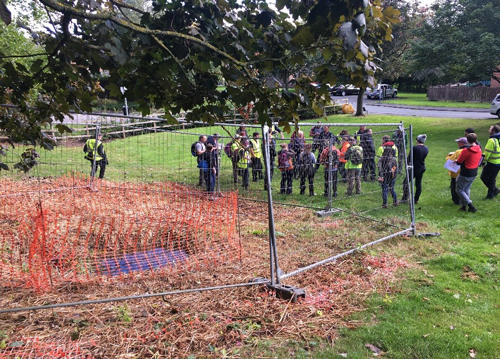Hannah Gow reports on the use of improved conceptual models of subsurface geology to aid planning and hazard mitigation in a region renowned for complex engineering geology and sinkholes.
Gow, H., That sinking feeling.
Geoscientist 28 (10), 24, 2018
Ripon, a small and pleasant cathedral city in North Yorkshire, made headlines in recent years when sinkholes opened up in 2014, 2016 and as recently as this August. During the 1980s and 1990s, sinkholes appeared in the area every two to three years. The geological sequence of marls, limestone and gypsum combined with the topographic groundwater flow, makes Ripon highly susceptible to dissolution features such as sinkholes. On September 7-9, the Engineering Group of the Geological Society met for their Annual Field Meeting to discuss the geological hazards and engineering implications of the dissolution features there. We also discussed the Quaternary Geology of the Vale of York, which is characterised by glacial moraines and lake sediments, till and gravel left over from the last ice age. The aim was to explore conceptual ground models for these regions and to share our knowledge and experience with Engineering Geologists across academia and industry.
Organised by David Giles (University of Portsmouth) and led by staff from the British Geological Survey and Technical Solutions in Partnership (TSP) Projects, over 40 delegates with backgrounds ranging from engineering geology to consultants to students attended to learn about the geological history of the Vale of York and sinkholes in Ripon.
The Friday evening kicked off with talks by Holger Kessler, Callum Irving (TSP), Vanessa Banks and myself. We gave an overview of the Quaternary history, mapping and modelling of the areas we would visit over the next two days. The talks went on late into the evening, but we were raring to go again on Saturday morning, starting the day with site visits to the Escrick Moraine. Jon Ford, Holger Kessler and Callum Irving, provided an in-depth narrative of the geological history and engineering properties of the ground in the area. The shallow geology and landscape of the Vale of York between Selby and York records a legacy of dynamic Quaternary evolution. The group retraced this geological history, visiting key localities that reveal the diverse and often complex nature of the superficial deposits. Our discussions focussed on relationships between geological processes and the ground properties, their engineering implications, as well as impacts on the region’s hydrogeology. We saw how the depositional environments and glacial history, including ‘glaciotectonism’, affect materials and their potential applications. Our excursion led us to the University of York campus where we were able to bring our geological history tour into the Anthropocene, discussing the role of human landscape modification on the region’s Quaternary geology.
As is typical for a field visit, it rained for most of the day and we came away a few inches taller due to clay from Wilberfoss Quarry that stuck to the bottom of our wellingtons!

On Sunday, Tony Cooper led us to various sites around Ripon to look at sinkholes. One had opened up only in the last five months. At first glance, it could be mistaken for a lovely village pond, were it not for the bright orange fencing and the fact that similar-looking holes appear quite often in Ripon! The sinkholes form because Ripon is underlain by gypsum that rapidly dissolves in water on a human timescale of years to decades. This dissolution causes cavities to open and the ground above to collapse—a process that can be triggered by natural dissolution or human intervention, such as a burst water pipe. Dave Morgan demonstrated to the group a range of geophysical survey techniques that can be used to better understand the geometry and processes occurring within a sinkhole. With improved understanding of sinkholes, we can create more detailed ground models and interpretations of sinkhole formation to aid hazard mitigation in the city.
This part of northern England has truly intriguing geology. It is easy to see why some believe the Ripon sinkholes were the inspiration for Lewis Carroll’s Alice in Wonderland falling down a deep hole following the white rabbit.
Hannah Gow is a Spatial Data Specialist and Geoscientist at the British Geological Survey; e-mail:
[email protected]
Further reading:
https://www.geolsoc.org.uk/engineering
https://www.bgs.ac.uk/research/engineeringGeology/shallowGeohazardsAndRisks/gypsum.html
Image credit: Hannah Gow (BGS)